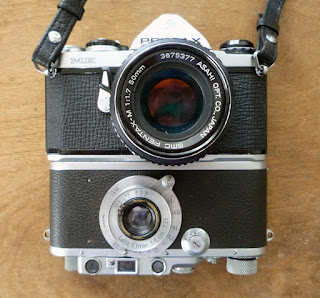I was one of the first visitors through the gate of the Rio Grande Zoo on Friday morning. I was alone for much of the hour circuit of the exhibits. As it turned out, there were also few animals to be seen as most had yet to be let into their outdoor spaces. I decided to head back toward the exit by way of the Africa section and found to my delight that the hippos and their month-old baby were in the pond.
The cheetah's enclosure is near the hippos and they were also active, possibly inspired by the cool morning air.
I gave the expired Fuji 400 an extra stop of exposure and some extra time in the Cinestill C-41 to compensate for the film's age and the fact that this was the 13th roll through this processing kit. The aperture-priority automation of the Pentax ME makes it a very pleasant camera to shoot; all these shots were made with the SMC Pentax-A f/2.8 135mm lens.The camera's well-placed controls, bayonet lens mount and compactness makes it a quick shooter. To appreciate the small size of this advanced slr it is worthwhile to compare it to my Leica IIIa; the body dimensions are nearly equal. Of course, that is a tribute to the pioneering Barnack design, as well as to the Japanese innovators who brought the 35mm format into the latter half of the Twentieth Century.






7 comments:
You know I'm a fan of the ME, so I'm always pleased to see you give yours some exercise. I went to give mine some exercise not long ago, only to find that the light meter has died. This ME was a $16 eBay purchase (plus an Eric Hendrickson CLA) -- I'm thinking rather than continuing to invest in that battered old thing, I should look for one in excellent condition and have it CLAd.
That, or just give up on Pentax and switch to my wonderful Olympus OM-2n.
My ME had a few issues when received, but they proved pretty easy to fix. Shooting it was a nice break for me from struggling with my old folders.
Cute baby hippo (of course, everyone loves babies of this sort).
The Pentax ME and MX were amazingly compact cameras, especially considering they were SLR design, had internal light meters, could change finder screens (at least this was applicable for my MX) and could mount motor drives. The finders were brighter than the finders in Spotmatics. However, I think the classic older Spotmatics were a bit more rugged, but as the decades go by, all of these cameras will be a bit troublesome. I have a Spotmatics II that should go visit Mr. Hendrickson for his tender loving care.
I recall being hugely impressed with the handling of the the ME right after I fixed a few small issues. That got me curious about what I had been shooting immediately prior to the ME. So, I looked back at 2017 and found that just before the ME I had taken out the Minolta SRT 202. That is also a very capable camera with great lenses, but as I recall it weighs about twice as much as the ME. So no real contest in terms of compact ergonomics, and the Pentax SMC 1.7 is really phenomenal.
I'm glad you're having good luck with c-41 processing at home. There must be a hitch in my own process somewhere along the line. I get about 4 or 5 rolls in and find tiny white spots when I go to scan. Something is getting contaminated and I have no idea what. These look great, though.
I've had the same problem off and on. Recently, I've been lucky with some older Fuji. You might try a different film.
I had the same problems with white spots and use Cinestill c41. I traced them back to two issues: sediment in the c41 chemicals and the improper way I was using PhotoFlo. Now, I use paper coffee filters to strain the chemicals before each use. As for the PhotoFlo, I stopped putting it in the development tank (I was actually taught this in a class). Instead I pour a small amount in a bowl and run the negative through twice before drying. No more white spots!
Post a Comment